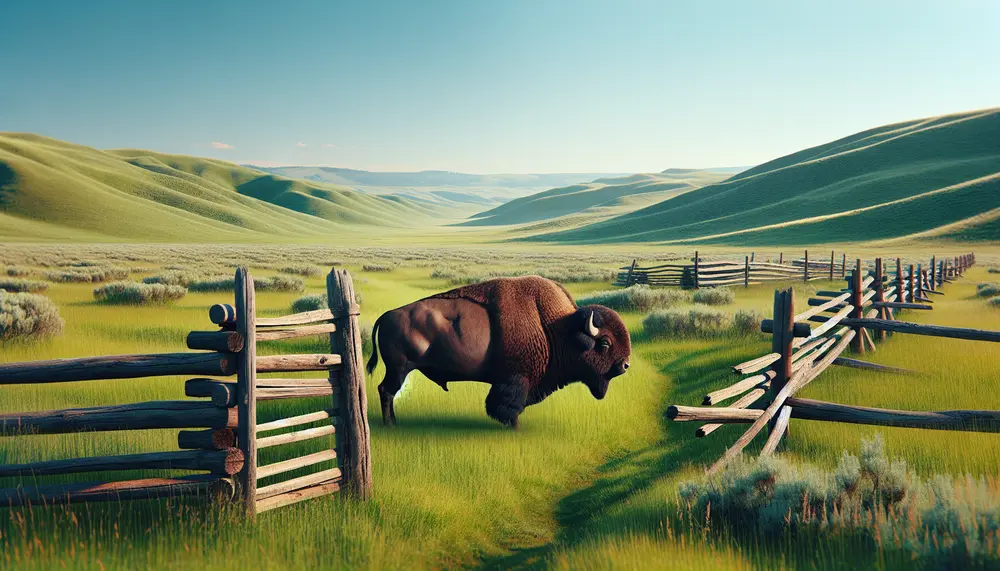Table of Contents:
Understanding Bison: An Introduction to the Majestic Creatures
Understanding Bison: a term that conjures images of vast plains and resilient, majestic creatures. Bison, commonly known for their grand stature and wild spirit, have roamed the Earth for centuries, playing a crucial role in the ecosystem and the heritage of many cultures. These animals, often mistakenly called buffalo, are a symbol of strength and endurance. They are not merely remnants of a bygone era but active participants in our world's biodiversity.
As the largest mammal in North America, bison have a presence that demands respect and awe. Their sheer size, which can exceed a ton, is complemented by their unique physical attributes, including their iconic hump and thick, shaggy coat that enables them to endure harsh winters. Despite their bulk, bison exhibit surprising agility and can reach speeds of up to 35 miles per hour. This agility, combined with their keen senses, makes them well-adapted to their environments.
- The platform impresses with an intuitive interface for quick access to features.
- Through integration into the Tobit.Software ecosystem, Bison App works seamlessly with products such as chayns, simplifying processes.
- Bison App allows mobile access to key features, enhancing work flexibility and efficiency.
- It offers extensive customizations to tailor it to individual business needs.
- Bison App is continuously updated to provide users with the latest features for competitive advantages.
This provider meets the editorial requirements for listing on this website. We are currently gathering experience with this provider and will publish it shortly.
Integral to understanding these creatures is the knowledge of their social hierarchy. Bison are gregarious animals, often found in herds that can number in the hundreds. These herds are complex social structures with females, or cows, forming the core, and males, or bulls, typically leading a more solitary existence except during the mating season. The mating season, or rut, is a sight to behold, as bulls vie for dominance and the right to mate with the receptive females.
While they once roamed the grasslands in vast numbers, bison populations faced near extinction due to overhunting and habitat loss in the late 19th century. It is a testament to conservation efforts that bison numbers have rebounded, though they still face challenges today. Recognizing the important ecological role they play in grassland management, as they prevent overgrowth and help in seed dispersal, is crucial to appreciating their contribution to environmental health.
In conclusion, bison are not only an icon of the American West but also a living testament to nature's magnificence. As stewards of the earth, it is our responsibility to continue to learn about and protect these formidable creatures that represent so much more than meets the eye. They are indeed a key thread in the tapestry of biodiversity, deeply interwoven into the survival and flourishing of the habitats they graze upon.
The Natural Habitat of Bison: Where Do They Roam?
The Natural Habitat of Bison: These enormous grazers have historically been associated with the great plains of North America. However, their range once extended much further, from Alaska down to Mexico and from the Pacific Northwest to the eastern Appalachian Mountains. Today, their roaming grounds have been significantly reduced and they primarily reside in protected areas such as national parks and reserves as well as private ranches.
Bison prefer open grasslands and prairies as these environments provide the ideal conditions for grazing. Their habitat is also characterized by rolling hills and river valleys, where they have access to water sources essential for their survival. Despite their size, bison are migratory creatures and would traditionally move through vast distances with the seasons to find fresh pastures and to avoid deep snow in the winter.
Parks like Yellowstone National Park in the United States are strongholds for wild bison populations. In these protected areas, they live relatively undisturbed, mirroring the life they led before their numbers dwindled. Restoration of bison into these areas not only benefits the species but also stimulates the health of the grassland ecosystem, increasing biodiversity and maintaining the integrity of these landscapes.
In cases where bison are reintroduced into their former habitats, careful management is required to ensure that ecosystems can sustain their presence. Bison can be an integral part of grassland management plans, helping to maintain the balance between different plant and animal species. Their impact on these habitats, including effects on soil health and vegetation structure, demonstrates their role as a keystone species.
To appreciate the current state of bison in the wild, it is essential to recognize the conservation success stories that have allowed them to reclaim portions of their historic range. However, with ongoing threats such as habitat fragmentation and conflicts with agricultural land use, the importance of ensuring healthy habitats for bison remains an ongoing challenge for wildlife conservationists.
Pros and Cons of Bison in the Ecosystem
| Pros | Cons |
|---|---|
| Essential for grassland ecosystems maintenance | Can damage farmland when populations are uncontrolled |
| Contribute to biodiversity | Compete with livestock for grazing areas |
| Promote soil health through grazing patterns | Critical if they stray onto roadways |
| Attract tourism and support local economies | Expensive to manage in national parks and reserves |
| Symbol of American heritage and conservation success | Risk of disease transmission to other species, including cattle |
Bison Behavior: Social Structure and Daily Activities
Bison Behavior: Delving into the daily lives of bison, we find a species with complex behaviors and a structured social system that is fascinating to observe. A bison herd is not just a group of animals; it's a dynamic community where each member plays a specific role.
Day-to-day activities of bison revolve predominantly around two essentials: grazing and resting. As herbivores, they spend a significant portion of their time consuming grasses, necessitating a lifestyle that involves constant movement within their habitat to access fresh patches of pasture. When they are not feeding, bison often engage in resting and ruminating, part of their digestive process, which is crucial for their wellbeing.
Their social interactions are even more pronounced during the breeding season, also known as the rut. During this time, males display a range of behaviors from bellowing to displaying physical prowess in order to attract females and assert dominance. Outside of the rutting season, bison exhibit behaviors that foster community bonds, such as grooming, which contributes to the social cohesion of the herd.
Young bison, or calves, stay close to their mothers for the first year of their lives, learning the ways of the herd and gaining protection from potential predators. These family units within the larger herd structure are critical to the survival of the young and the education of future generations.
Another key aspect of their behavior is the tendency for bison to form sub-herds, typically comprised of females and young, led by a mature female, while mature males often form smaller groups or remain solitary. These sub-herds can merge into larger conglomerates during certain seasons or in response to environmental pressures.
Bison also play an essential role in their environment through their behaviors, contributing to seed dispersal and soil aeration through their grazing patterns and movements. As a keystone species, the behaviors of bison are influential in shaping the grassland ecosystem.
In sum, the bison's daily activities and social structure are intricately linked to their survival and health as a species. Appreciating these behaviors enriches our understanding of bison and highlights the importance of ensuring that these majestic animals continue to thrive in their natural habitats.
Physical Characteristics of Bison: Identifying Features
Physical Characteristics of Bison: Bison are characterized by their impressive and distinctive body features which are critical for their survival in the wild. Their thick fur is perhaps the most notable trait, providing insulation against the bitter cold of winter. The fur includes a lighter summer coat that they shed to help stay cool during warmer months.
The bison's large head is framed by a pair of short, curved horns that are used for defense and in battles for dominance among males. These horns are a permanent feature and grow throughout the bison's life. A mature bison's horn span can be used to help determine its age and health.
Their distinctive shoulder hump is another identifying feature, which is supported by strong spinal muscles that aid in their powerful movements and ability to forage through snow. Below this hump, their body slopes down towards the rear, giving them a rugged, uneven profile that distinguishes them from other bovine species.
Further defining their appearance are the bison's massive legs and hooves, which are well-adapted for long-distance travel and swift movement when necessary. These legs support their heavy frame, while their hooves are suited for various terrains, from the soft prairie to rocky substrates.
Their eyes and ears are relatively small compared to their body size but are well-suited for their needs. Bison have excellent hearing and a keen sense of smell, which they rely on to detect predators and communicate within the herd.
The overall physique of the bison, including their bulky build and robust features, is designed for survival and resilience. While their appearance is iconic, it is also a testament to their evolutionary adaptations which have allowed them to thrive in diverse environments.
The Diet of Bison: What's on Their Menu?
The Diet of Bison: As grazing mammals, bison are primarily herbivores, with a diet that focuses on grasses and sedges found in their prairie habitats. Their foraging behavior is adapted to the availability of vegetation, which varies seasonally in the regions they inhabit.
In the spring and summer, their diet is rich in nutrition as they take advantage of the new growth that these seasons bring. Lush grasses high in protein and other nutrients are abundant, allowing the bison to build up reserves of fat that will sustain them through tougher times.
As fall approaches, bison shift their diet slightly to include a wider variety of plants. They may consume shrubs and leaves when grasses begin to dwindle, showcasing their ability to adapt their eating patterns to the changing environment.
Winter poses a greater challenge as the snow covers their food sources. Bison use their muscular heads and strong necks to sweep away snow, revealing dormant vegetation underneath. Despite the scarcity of food during this season, they manage to find sufficient sustenance to survive until spring.
It is worth noting that bison have a unique digestive system, similar to other ruminants, which allows them to break down cellulose in plants. This multi-chambered stomach facilitates microbial fermentation of the plant material, making it easier to digest and obtain nutrients from otherwise indigestible matter.
Understanding the diet of bison is not just about what they eat but also about the role they play in the ecosystem. The grazing patterns of bison help to maintain the health of grasslands by preventing overgrowth and promoting biodiversity. Their movement across the landscape also aids in dispersing seeds, thereby facilitating the growth of new vegetation.
Bison Conservation: Efforts to Protect and Preserve
Bison Conservation: Protecting and preserving bison is crucial as their existence is intertwined with the health of North America's grasslands. Despite the rebound in their numbers from the brink of extinction, they continue to face threats from habitat loss and fragmentation, disease, and genetic diversity issues due to their limited population sizes in conservation herds.
Conservation programs have been pivotal in the resurgence of bison populations. These initiatives typically involve breeding programs, habitat restoration efforts, and legislative actions to encourage the protection of these majestic animals. Partnerships between governmental agencies, Native American tribes, wildlife conservation organizations, and private landowners have been instrumental in these conservation efforts.
One of the key strategies in bison conservation has been the establishment of wildlife reserves and national parks where bison can roam freely and live in a natural state. The establishment of wildlife corridors has also helped to connect different herds, allowing for genetic exchange and healthier populations.
Moreover, public education and awareness campaigns play a vital role in bison conservation. By informing the public about the importance of bison to biodiversity and the prairie ecosystem, conservation groups can build support for their protection and management measures. Such programming often includes opportunities for people to directly engage with conservation work, such as volunteering for habitat restoration projects or participating in 'adoption' programs to finance bison management.
Recent advancements in science and technology, including genetic studies, help conservationists understand the genetic health of bison populations, which is vital for planning effective breeding and management programs. These studies guide efforts in maintaining the genetic purity of bison herds, especially in relation to their historical counterparts.
Bison conservation is an ongoing journey, one that requires vigilance and dedication to ensure these icons of the American prairies continue to thrive. Their return to the landscape is not just a triumph for the species but a beacon of hope for the restoration and preservation of America's natural heritage.
Bison in Culture and History: Symbolism and Significance
Bison in Culture and History: Beyond their ecological significance, bison bear a rich tapestry of cultural and historical importance. For numerous Native American tribes, the bison has long been a source of sustenance and a central figure in their spiritual beliefs and rituals. It represents not only a physical provider but also a symbol of sacred life and abundance.
In the stories and traditions of these cultures, bison embody strength, resilience, and the Earth's generosity. They feature prominently in art, from ancient petroglyphs to contemporary Native American crafts, depicting the respect and reverence held for these creatures.
The image of the bison is deeply ingrained in American history as well. Once roaming the Great Plains in colossal herds, they became icons of the untamed wilderness of the West. The near-extermination of bison in the 19th century has since become a cautionary tale of wildlife conservation and the consequences of unchecked exploitation.
Today, the bison stands as a national symbol, represented on coins, in state flags, and in various official emblems. The creature's likeness conveys a spirit of the American frontier and a reminder of the nation's past relationship with the environment.
The significance of bison also extends into the economic realm where they have been, and continue to be, a source of commerce through the bison meat and hide industries. However, the commercial aspect is managed with consideration to their well-being and conservation status.
The legacy of the bison inspires ongoing efforts to honor and preserve their place in both the natural and cultural landscapes. As we foster a deeper understanding and appreciation for bison, it becomes clear that their continued existence is not only a boon to biodiversity but a commitment to honoring our history and enriching our culture.
Health Benefits of Bison Meat: Nutritional Value Explained
Health Benefits of Bison Meat: Bison meat is gaining popularity as a nutritious alternative to traditional livestock meats like beef. Recognized for its lean composition, bison meat is lower in fat and calories while being high in protein, making it an attractive option for health-conscious consumers.
The nutritional profile of bison meat is impressive; it contains essential amino acids and is rich in iron and vitamin B12, both crucial for maintaining healthy blood cells and nerve function. Moreover, its high concentration of omega-3 fatty acids is beneficial for cardiovascular health, contributing to lower cholesterol levels and reduced inflammation.
Bison meat also provides a good source of minerals such as zinc, necessary for a strong immune system, and selenium, which plays a role in antioxidant processes. These nutritional benefits make bison meat a favorable alternative for individuals looking to improve their diet quality without sacrificing flavor.
Compared to other red meats, bison is also known for its more favorable saturated to unsaturated fat ratio. Consumers enjoy the tender, slightly sweet taste of bison, which results from the animals' grass-fed diet and the absence of artificial growth hormones and antibiotics in conscientiously raised herds.
The health benefits of consuming bison are encapsulated not only in its nutrient density but also in the holistic approach to farming and consumption. The sustainable practices often involved in raising bison contribute to a healthier environment and a superior quality of meat that is reflective of the animals' natural diets and habitat.
For those seeking a healthier red meat option, bison emerges as an excellent choice, offering a myriad of health benefits supported by its protein-rich, nutrient-dense, and low-fat characteristics. Its inclusion in a balanced diet can contribute to overall well-being, aligning with a wholesome lifestyle.
- The platform impresses with an intuitive interface for quick access to features.
- Through integration into the Tobit.Software ecosystem, Bison App works seamlessly with products such as chayns, simplifying processes.
- Bison App allows mobile access to key features, enhancing work flexibility and efficiency.
- It offers extensive customizations to tailor it to individual business needs.
- Bison App is continuously updated to provide users with the latest features for competitive advantages.
This provider meets the editorial requirements for listing on this website. We are currently gathering experience with this provider and will publish it shortly.
Bison Essentials: Top 5 FAQs
What is the natural habitat of bison?
Bison primarily inhabit open grasslands, prairies, and river valleys in North America. Historically, they roamed from Alaska to Mexico and from the Pacific Northwest to the eastern Appalachian Mountains, but today they are mostly found in protected areas like national parks and reserves.
How do bison contribute to the ecosystem?
Bison play a significant role in maintaining grassland ecosystems by preventing overgrowth and aiding in seed dispersal. Their grazing patterns promote soil health, attract tourism, support local economies, and contribute to biodiversity.
What are the physical characteristics of bison?
Bison are known for their large size, with males weighing over a ton, their thick and shaggy coats for enduring cold winters, their distinctive shoulder hump, and massive legs for long-distance travel. They have short, curved horns used for defense and social interactions.
What does a bison's diet consist of?
Bison are herbivores that graze on various grasses, sedges, shrubs, and leaves. Their diet is seasonal, with richer, more nutritious grasses consumed in spring and summer while they forage for whatever vegetation is available during fall and winter.
What efforts are in place for bison conservation?
Conservation efforts for bison involve breeding programs, habitat restoration, and legislative actions. Protected areas such as reserves and national parks allow bison to roam freely. Public education and awareness are also crucial to garner support for their protection and management.













